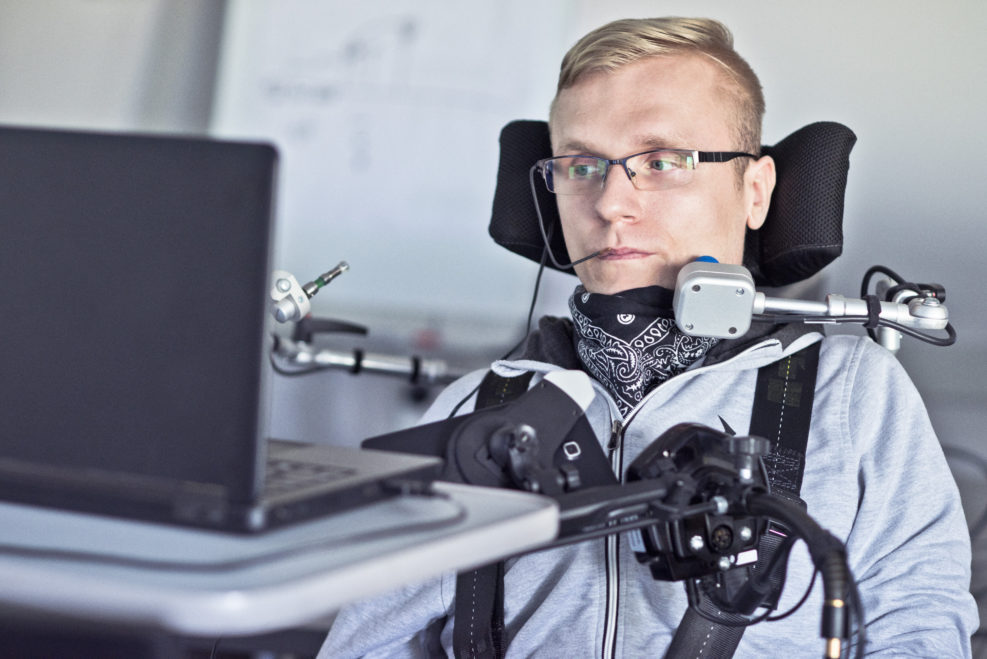
TagLanguage


Arrival Review, Part 3
Investigating the meaning of time and language
Arrival Review, Part 1
Nobody behaves like they should for the first ten minutes. They act, dare I say, alien.Arrival is an interesting movie. It’s well-shot, well-acted, and well-written. The trouble is the script makes some strange choices in the beginning and I just wasn’t persuaded by the movie’s twist at the end. The story starts out with a montage where Louise is raising her daughter, but the child tragically dies of some unknown illness, presumably cancer. The viewer is led to conclude that this is a flashback, but if one listens to the monologue Louise delivers, she says plainly that she’s explaining when the child’s story begins, if there are beginning at all, which is something she no longer believes. This basically means that the entire movie is a flashback, but the viewer is not supposed to notice Read More ›

Meta Introduces New Translator Tool
Meta's goal of making a universal translator is starting to materializeMeta has developed a new speech-to-text model that can translate almost 100 languages, according to The Verge. The announcement reflects Meta’s recent attempts to expand their AI sector. (RELATED: Meta’s Weird New Speech AI | Mind Matters) Emilia David writes, SeamlessM4T, which stands for Massively Multilingual and Multimodal Machine Translation, that the company said can translate speech-to-text and text-to-text for nearly 100 languages. For speech-to-speech and text-to-speech actions, it recognizes 100 input languages and converts them into 35 output languages. -Emilia David, Meta releases multilingual speech translation model – The Verge Meta’s ultimate goal is to make a “universal translator.” The multi-billion dollar technology company compared the new model to the “Babel Fish” in the novel The Hitchhiker’s Guide to Read More ›

It’s Not What It Looks Like
Our natural tendency to connect meaning with images is both a strength and a vulnerabilityThe human brain tends to think concretely. We barter thoughts, words, and ideas through images. It’s why metaphorical language can be so powerful in conveying otherwise abstract ideas. I immediately think of the verse in the Bible: “But let justice roll down like waters, and righteousness like an ever-flowing stream” (Amos 5:24). It’s hard for me to picture justice on its own, but a raging waterfall? That’s a powerful image. I can now imagine what justice, in some aspect, might look like. Our natural tendency to think this way is both a strength and a vulnerability. A recent article from The Stream relates the human imagination to the current conversation over AI. While the debates rage over AI’s most pertinent Read More ›

Awash in a Sea of Digital Information
In the age of infinite online text, maybe less is moreSome days after I close my laptop, I’d like to pick up a novel and read or work on a short story project, but then feel like I just need to empty my mind of all the snippets and clips of textual information I’ve consumed that day. News blurbs, thought pieces, emails, provocative tweets, more emails, more news blurbs… Frequently I’ll turn to a TV show or a social media binge in place of the novel. My brain can’t take any more text. It’s burnt out. It’s no secret contemporary Americans live in a sea of images and videos. YouTube, Instagram, TikTok, and Facebook all vie for human attention through images and color schemes designed to catch the distracted eye. Read More ›

Shakespeare vs. AI: Who Wins?
AI fails to do justice to the full range and depth of human languageI’ve written a fair bit in the last month on the development of AI art tools, but what about language? AI, as you’re probably aware, is not only able to mimic artistic styles. Its developers also want it to generate words, and to all appearances, they are succeeding. If visual artists are in trouble, how are journalists, novelists, and academics implicated in the AI revolution? I have a background in English, literature, and creative writing, so naturally, this AI issue hits a bit closer to home. Suppose an AI program could compose a short story with the prose quality and cohesive style of Ernest Hemingway. Could AI eventually produce news content, thus substituting the human reporter or journalist? As it Read More ›

Do Birds Really Understand What They Are Saying?
Remarkable claims are made for some birdsPerhaps because parrots can carefully mimic human voices (and many other sounds), many claims are made for their intelligence For example, that they understand abstractions like currency: After training eight African grey parrots and six blue-headed macaws to barter metal rings for walnuts, the researchers paired the birds up with same-species partners. They then put the parrots in clear chambers joined by a transfer hole, and gave one bird—the donor—ten rings, while the other was left with none. Even without the promise of a reward for themselves, seven out of eight of the African grey parrot donors passed some of their available tokens through the transfer hole to their broke partners, usually shuttling them beak to beak. On average, about Read More ›

Is the Key to Human Language To Be Found In Singing Birds?
If singing birds can explain human speech, why aren’t the birds all giving interviews?That’s the claim of a recent article in Cognitive Sciences: The study is based on evidence from diverse fields such as archaeology, evolutionary genomics, neurobiology, animal behaviour and clinical researcher on neuropsychiatric disorders. With these, it shows that the reduction of reactive aggressiveness, resulting from the evolution and process of self-domestication of our species, could have led to an increase in the complexity of speech. According to the authors, this development would be caused by the lowest impact on brain networks of stress hormones, neurotransmitters that activate in aggressive situations, and which would be crucial when learning to speak. To show this interaction, researchers analysed the genomic, neurobiological and singing-type differences between the domesticated Bengalese finch and its closest wild Read More ›

Can AI “Translate” Animal Languages Into Human Languages?
If we understood animal communications better, would they even seem like a language?That’s the question science writer Philip Ball, author of The Modern Myths: Adventures in the machinery of the popular imagination (2021), posed recently at The New Yorker. If a dolphin could talk, could we really understand its very different life experiences? Ball reports that some researchers are trying to translate dolphin communications (“dolphish”) into English: Today, animal-translation technologies are being developed that use the same “machine learning” approach that is applied to human languages in services such as Google Translate. These systems use neural networks to analyze vast numbers of example sentences, inferring from them general principles of grammar and usage, and then apply those patterns in order to translate sentences the system has never seen. Denise Herzing, the founder Read More ›

How a Searchable Database Is Helping Decipher a Lost Language
A cryptographer “solved” Minoan B from ancient Cretan culture in the 1950s but Minoan A remained a mystery until recentlyThere was once a flourishing civilization on the island of Crete called the Minoan culture (3000–11100 B.C.). Two languages are associated with it, Minoan A and, later, Minoan B. Minoan B was deciphered but Minoan A has remained a mystery that has “tormented linguists for many decades,” as Patricia Klaus puts it. Deciphering it would give us a window back as far as 1800 BC.: Linear A, which was used by the Minoans during the Bronze Age, exists on at least 1,400 known inscriptions made on clay tablets. The language has baffled the world’s top archaeologists and linguistic experts for many years. Patricia Claus, “Minoan Language Linear A Linked to Linear B in Groundbreaking New Research” at Greek Reporter (May Read More ›

Cognitive Scientist: Earliest Humans, Homo Erectus, Had Language
Homo erectus needed a language to enable such remarkable achievements over 100,000 years ago, he saysMany experts believe that language has been a late development in human history. As Daniel Everett puts it, “many paleoanthropologists view erectus as little more than a skinny gorilla, of few accomplishments, far too stupid to have language, and lacking a vocal apparatus capable of intelligible speech.” Everett (pictured) disagrees and asks us to look at some facts from paleontology: Evidence that erectus had language comes from their settlements, their art, their symbols, their sailing ability and their tools. Erectus settlements are found throughout most of the old world. And, most importantly for the idea that erectus had language, open oceans were not barriers to their travel. Erectus settlements show evidence of culture – values, knowledge structures and social structure. Read More ›

Paralyzed Man Writes, Using Only Imagination — and an Algorithm
With implanted electrodes, the volunteer, 65, achieved 90 characters per minuteThe science media has been abuzz these last few days with news of man paralyzed from the neck down who was able to type using only his thoughts — communicating via a brain implant: A 65-year-old man had two grids of tiny electrodes implanted on the surface of his brain. The electrodes read electrical activity in the part of the brain that controls hand and finger movements. Although the man was paralyzed from the neck down, he imagined writing letters softly with his hand. With an algorithm, researchers then figured out the neural patterns that went with each imagined letter and transformed those patterns into text on a screen. Anushree Dave, “Brain implants turn imagined handwriting into text on a Read More ›

No AI Overlords?: What Is Larson Arguing and Why Does It Matter?
Information theorist William Dembski explains, computers can’t do some things by their very natureYesterday, we were looking at the significance of AI researcher Erik J. Larson’s new book, The Myth of Artificial Intelligence: Why Computers Can’t Think the Way We Do, contrasting it with claims that AI will merge with or replace us. Some such claims are made by industry insiders like Ray Kurzweil. But more often we hear them from science celebs like the late Stephen Hawking and Richard Dawkins, who, on these topics, are more known than knowledgeable. So why does Larson think they are wrong? He offers two arguments. First, as information theorist William Dembski explains, is that there are some kinds of thinking that, by their nature, computers don’t do: With regard to inference, he shows that a form Read More ›

Babies Can Understand Whole Sentences Before They Can Speak
Before uttering their first word, a new study suggests, children can understand what groups of words mean togetherIn a recent study of 11–12 month olds published in Cognition, researchers found that infants on the verge of saying single words themselves can already process complete sentences such as “Clap your hands.” The research sheds light on the difficulties adults have learning second languages if they focus too intensely on single words: Dr Barbora Skarabela, of the School of Philosophy, Psychology and Languages Sciences, said: “Previous research has shown that young infants recognise many common words. But this is the first study that shows that infants extract and store more than just single words from everyday speech. This suggests that when children learn language, they build on linguistic units of varying sizes, including multiword sequences, and not just single Read More ›

AI Can Fight COVID by Detecting Changes in Virus “Language”
One research team is experimenting with natural language processors (NLP), used to analyze human speech, to detect similar virus mutationsOne strategy in the fight against COVID-19 relies on the curious fact that genetics is actually a language. Genome sequencer Francis Collins has even called it The Language of God. More practically, AI programs that act as natural language processors can help catch deadly coronavirus mutations. The same strategies the AIs use for reading sentences can be used to read the virus’s attempts to escape destruction by mutations: Galileo once observed that nature is written in math. Biology might be written in words. Natural-language processing (NLP) algorithms are now able to generate protein sequences and predict virus mutations, including key changes that help the coronavirus evade the immune system. The key insight making this possible is that many properties of Read More ›

How Much of Neuroscience Is an Unwitting Hoax?
Philosopher Ludwig Wittgenstein saw that much materialist neuroscience was neither true, nor false, just nonsenseIn 1996, NYU physics professor Alan Sokal published an article in a journal of postmodern cultural studies. The article, “Transgressing the Boundaries: Towards a Transformative Hermeneutics of Quantum Gravity,” was a hoax. Sokal simply assembled more or less meaningless phrases about cultural theory and quantum physics in a grammatically correct but meaningless manuscript. He revealed the hoax a few weeks later in a magazine. The hoax ignited a storm of controversy and, in the view of many, revealed the essential sham at the core of postmodern philosophy. What Sokal (pictured) was doing, whether he knew it or not, was invoking philosopher Ludwig Wittgenstein’s salient critique of philosophy and science, which is that much of our discourse is language games. By Read More ›

AI Smash Hits 2020 Part I
An ultimate test of a successful technology is whether it has been reduced to practice. Has it made a financial impact on the market? Has it been adopted by the very picky US military? Has it changed lives? We’re going to count down the AI Smash Hits: the top ten AI success stories for 2020. Join Dr. Robert J. Marks as he Read More ›

Researchers: Human Brains Are Prewired To Recognize Words
Contrary to what psychologists had supposed, the ability to seek meaning is built in, not taughtZeynep Saygin at Ohio State and her colleagues challenged a long-standing belief that human brains are not pre-adapted to learn language: Humans are born with a part of the brain that is prewired to be receptive to seeing words and letters, setting the stage at birth for people to learn how to read, a new study suggests. Analyzing brain scans of newborns, researchers found that this part of the brain – called the “visual word form area” (VWFA) – is connected to the language network of the brain. “That makes it fertile ground to develop a sensitivity to visual words – even before any exposure to language,” said Zeynep Saygin, senior author of the study and assistant professor of psychology Read More ›

Why Does Science Embrace the “Talking Animals” Myth?
Many birds are quite smart but why do some researchers imply that they think like people?In recent years, studies have confirmed a widespread cultural intuition that some birds, particularly corvids like crows and ravens, are “smart.” They show considerable problem-solving skills. Thus, they loom large in mythology as messengers and tricksters. For example, the Norse king of the gods (pictured) had two ravens as advisors. Oddly enough, science today retains the mythology and makes a curious use of it: New discoveries about the specifics of corvid brain organization and intelligence are framed as demonstrating that humans do not really have as exceptional thinking ability as we suppose: Research unveiled on Thursday in Science finds that crows know what they know and can ponder the content of their own minds, a manifestation of higher intelligence and Read More ›